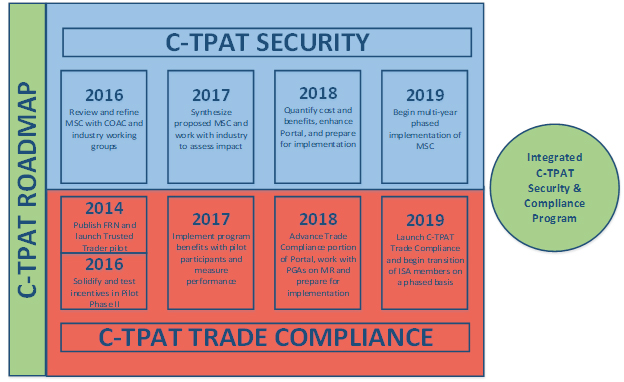By Philip Sutter, Director, Strategic Analysis
The U.S. Customs and Border Protection (CBP) agency presented its C-TPAT Roadmap for the future of the program at the Customs-Trade Partnership Against Terrorism (C-TPAT) 2017 Conference held August 29-31, 2017 in Detroit, Michigan. CBP’s C-TPAT Executive Director, Richard DiNucci outlined the state of the program, described the recent steps taken and where they plan to be by fiscal year (FY) 2019. Of note, the C-TPAT Roadmap (see chart below) is split into security and trade compliance plans that will ultimately merge into an integrated program. The new C-TPAT will be the integral piece of CBP’s Trusted Trader Strategy.

A major part of the security roadmap is an update to the Minimum Security Requirements (MSRs). The MSRs have not seen a change since the beginning of the C-TPAT program. CBP is keeping the changes tight to the vest. Without providing specifics, they did identify that cyber security will be part of the new requirements. Safeguarding in-transit cargo will also be a focus. CBP calculates that 85% of breaches of security occur between point A and B. In addition, personnel screening, food supply safety, and terrorism financing will be addressed by the revised MSRs.
CBP says there is a strong case for change. Trade volumes have dramatically increased. Meanwhile, the threats seen back in 2001 have evolved along with the precautions necessary to counteract them. The coordinated effort of CBP field personnel, CBP supply chain security specialists, private sector representatives, and the Commercial Customs Advisory Committee (COAC) continues to refine the MSRs.
During FY 2018, CBP will be quantifying the cost and benefits of the amended MSRs. They will prepare for implementation and launch a multi-year phased implementation of the MSRs in FY 2019. CBP stated that they will be socializing the specifics soon.
We’ve seen it coming; the plan is to merge the elements of the historical C-TPAT security program with a trade compliance program. Up to now the CBP trade compliance program, known as Importer Self-Assessment (ISA) has been separate, distinct, and consisting of far fewer participants (several hundred) than C-TPAT membership (11,500). CBP expects the numbers to increase as the Centers of Excellence and Expertise (CEEs) are more involved in managing Trusted Trader accounts.
The Trusted Trader pilot program introduced in FY 2014 that currently involves seven test companies is helping CBP evolve the program. CBP is working within the pilot to implement benefits and measure performance with an operational metrics dashboard. CBP wants to demonstrate that the benefits of participation outweigh its cost.
During FY 2018, the C-TPAT Portal will be built out to handle trade compliance as well as work with Partner Government Agencies on a “one U.S. government” approach. Finally, in FY 2019, ISA members will be transitioned to the new program.
Whether or not you agree that security and trade compliance should be combined, this will be a catch-up move. At present, 69 countries have adopted Authorized Economic Operator (AEO) programs that combine the two concepts.
The new C-TPAT will remain a voluntary program. Especially for the C-TPAT Trade Compliance portion of the program, the key for success will be to entice participation with trade facilitation benefits. CBP wants the program to be available for small and medium sized companies by making the program flexible, scalable, and attainable for various business models. Global companies may look forward to greater benefits related to their international operations with countries that the U.S. has Mutual Recognition Arrangements with. There may be opportunities for interoperability alignment between the programs.
As an international trader dependent on trade facilitation, take notice of the evolution of the coming changes to C-TPAT and Trusted Trader program. You will need to evaluate additional participation and assess how you will react to changes made to the minimum security requirements and the incorporation of the trade compliance component.